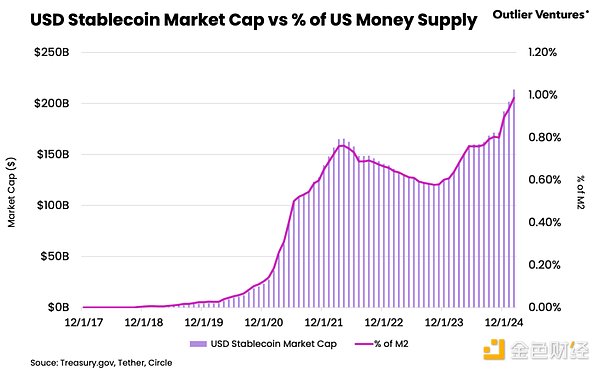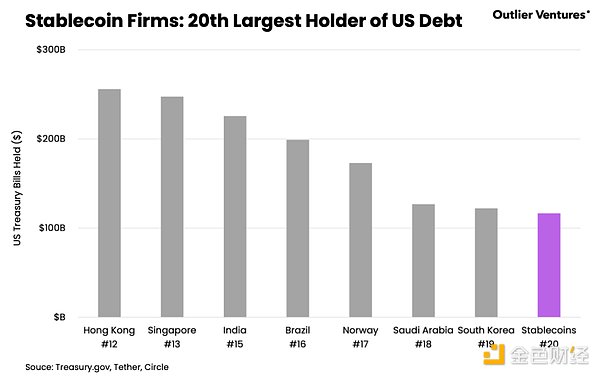Author: Greysen Cacciatore, Research Assistant at Outlier Ventures; Jasper De Maere, Research Director at Outlier Ventures;
Translation: Jinse Finance xiaozou
USD stablecoin market capitalization has exceeded $220 billion, accounting for 1% of the US money supply. With upcoming US stablecoin legislation set to allow new issuers such as banks, fintech companies, enterprises, and governments to enter the market, the industry is approaching a turning point that will fundamentally change the competitive landscape, distribution models, and industry innovation. More importantly, the underlying business model of stablecoin issuers provides innovative opportunities for the US government: expanding the base of short-term debt buyers through financial engineering and extending the global influence of the US dollar through digital currencies.
1. Key Points
* Total USD stablecoin market cap has exceeded $220 billion, approximately 1% of the US M2 money supply, growing 59.7% year-to-date, with the M2 ratio increasing by 40.9% year-on-year.
* Stablecoin issuers have become the 20th largest direct holders of US Treasury bonds, surpassing sovereign nations like Germany and Mexico, highlighting market growth potential and creating strategic opportunities for aligning stablecoin regulation with fiscal and geopolitical objectives.
* Despite Tether and Circle still dominating the stablecoin market with 89% market share, US legislation is opening doors for new participants like banks and enterprises - their extensive distribution channels could reshape market competition.
2. From Niche to Macro: Scaling Digital Dollars
Stablecoins have undoubtedly become the main theme in the cryptocurrency domain by 2025. As of Q1 2025, USD stablecoin market cap has exceeded $220 billion (99.8% of fiat-pegged stablecoin total volume), approximately 1% of US M2. Total market cap grew 59.7% year-to-date, with the USD stablecoin/M2 ratio increasing 40.9% year-on-year (see chart below).

This trend not only reflects the steady growth of digital dollars but also demonstrates the accelerating migration of economic activities to distributed ledger infrastructure. Stablecoin settlement value exceeded $24 trillion last year, proving itself as the infrastructure for blockchain finance and commerce through its stable, highly liquid, and programmable exchange medium characteristics.
Looking ahead to 2025, stablecoins are increasingly demonstrating their global financial influence in sovereign debt markets and geopolitical landscapes. Their business model provides the US government with a unique opportunity to reinforce dollar hegemony through digital assets: by legislatively incentivizing new issuers to operate in the US, they can expand the short-term debt buyer base through financial engineering, stimulate US debt demand, and strategically extend the dollar's monetary influence. Clear regulation will also attract enterprises, institutions, and even governments to consider issuing stablecoins, creating a new market competitive landscape.
3. Stablecoin Companies: New Powerhouses in the US Treasury Market
The digital asset industry generally recognizes that the stablecoin business model is extremely beneficial to issuers. Most stablecoins are backed 1:1 by cash and highly liquid assets (primarily short-term US Treasuries). Unlike banks or money market funds, stablecoin issuers do not distribute reserve asset returns to holders, instead exclusively enjoying interest spread income - creating substantial revenue streams based on interest rate environments and stablecoin demand.
On a global macro level, this model is generating new structural demand for US Treasuries. The two major issuers, Tether and Circle, collectively hold $116 billion in US Treasuries, placing stablecoin companies among the top 20 direct US Treasury holders, surpassing sovereign nations like Germany and Mexico (see chart below).

This phenomenon signifies that stablecoins are no longer just infrastructure for crypto-native markets, but a new global financial force. As their role in the US Treasury market becomes prominent, the US gains innovative opportunities to align stablecoin adoption with national fiscal interests. US Treasury Secretary Scott Bessent explicitly stated at last month's White House crypto summit: "We will maintain the dollar's global dominant reserve currency status, and stablecoins are the tool to achieve this goal", indicating that authorities are viewing stablecoins as a strategic tool to defend dollar hegemony.
More profoundly, each new issuer is a channel for digital dollars to penetrate the global economy. In emerging markets with persistent inflation, strict capital controls, and unstable local currencies, stablecoins provide individuals and enterprises with convenient hedging tools. Through forward-looking legislation, the US can accelerate global stablecoin adoption, enhancing dollar accessibility and expanding monetary policy influence. Thus, stablecoins serve as both a lever of domestic fiscal strength and a new tool for dollar globalization.
4. Future Outlook: New Issuers and Market Structure Evolution
With the US stablecoin regulatory framework rapidly improving, the overall stablecoin market structure is about to undergo transformation. The SEC's Corporate Finance Division recently clarified that USD-pegged stablecoins backed by low-risk liquid assets do not constitute securities. Combined with the STABLE and GENIUS Acts, this will pave the way for powerful new participants like enterprises, fintech companies, banks, and governments. New issuers with mature distribution channels are likely to reshape competitive landscapes and innovation directions while strengthening stablecoins' overall role in financial commerce.
Currently, Tether and Circle dominate the stablecoin market with 89% market share (see chart below), a concentration reflecting the historical impact of first-mover advantages and network effects.

While market share erosion remains uncertain, the risk reduction brought by clear regulation will provide new issuers with strong financial channels an opportunity to challenge existing giants. Banks and top fintech companies are particularly advantaged - they can integrate stablecoin products into existing capital market infrastructure and customer distribution networks. Beyond financial institutions, large consumer-facing enterprises also hold immense potential: leveraging massive user bases and brand stickiness, they can incentivize users to adopt their issued stablecoins through promotional discounts.
Overall, as the number of issuers increases, user experience will become a critical bottleneck. When hundreds of institutional/corporate/governmental stablecoins exist in the market, elegant solutions will be needed to address blockchain infrastructure, cross-chain interoperability, instant redemption, atomic exchanges, and deposit/withdrawal channels to drive scale growth and adoption.






